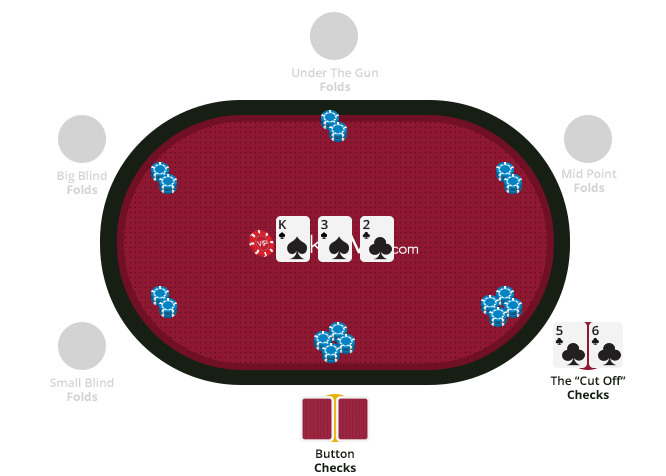This two part series analyses some of the most common leaks found in games of players at different levels. Part Two deals with undefended checking ranges, missing 'red-line' (non-showdown winnings) situations, lack of betsizing variation and efficiency (or lack of efficiency) with our river calls.
Undefended Checking Ranges
This is a slightly

more advanced leak that has application to some of the higher limit players I work with. It covers a wide range of situations so we'll just discuss one basic one.
Let's assume we open-raise and get one caller. We are OOP on the flop and decide to check. Many players are
- check-folding over 60% of the time (sometimes even 80%+)
- never check raising
- calling with a range that is capped.
A good player can basically bet any 2 cards every single time we check in this situation. In order to have a more complete strategy we need to check some strong hands to protect our range, and also check some hands with good backdoor potential which we can check-raise bluff with.
Having a weak strategy in this spot can also have a damaging effect on our turn play. Assuming we purely check/call the flop with 2nd pair type holdings we won't have a turn check-raising range. Assuming we occasionally check/call slowplay the flop with some sets, and also check/call some backdoor draws we now have a turn check/raising range for value and bluffs.
Missing Red-Line Situations
I refer to a situation where we can easily pick up the pot without showdown as a red-line situation. In most games we can be extremely unbalanced and fire any 2 cards in these spots with a good effect on our red-line and our winrate.
For example, let's imagine we check back the flop rather than cbetting and our opponent decides to check to us again on the turn. In most lower limit games we can fire any 2 cards in this spot. If our opponent hand anything decent he would lead the turn.
In other words our delayed cbet stat should probably be very high as an exploitative measure, sometimes even above 80%. It's very common to see delayed cbet values of 40-50% which indicates the player is missing out on a huge amount of non-showdown profit.
Or another situation where our opponent is the one who checks back the flop, and the action is on us OOP on the Turn. We should be leading extremely aggressively on the turn.
Usually our opponent either doesn't have anything or he is capped and will fold by the river. PT4 refers to such a turn lead as a “turn probe bet”. Our turn probe should likely be in the region of 80%, but again it's common to see players with 40-50% turn probe.
There are many similar situations, these are simply the two most common examples.
Static Bet Sizing
It's a simple fact that the vast majority of players who come to me for coaching:
- never overbet
- never underbet
These are hugely important tools in increasing our winrate. The vast majority of players always bet somewhere between 50-100% of pot.
While we can't go into detail on bet-sizing principles:
Underbets
- Allow us to extract thin value
- Allow us to get a better price on our bluff
Overbets
- Allow us to extract additional value
- Allow us to fold our opponents off a capped range
So as an example imagine a situation where we cbet the flop and our opponent calls. Turn goes check-check. On the river our opponents check to us OOP. The action is on us and we have air. When was the last time you overbet in that spot? Our opponents range is likely nearly always some sort of weak showdown value.
If he had a decent value hand he would bet. If he had an air-type hand he may also consider betting. So he will nearly always have some type of marginal showdown value that he is either planning on check/calling or check/folding.
If we overbet he may fold out 100% of his range. The reason we can get away with doing this comes back to the one of the earlier leaks we described. Our opponents checking range on the river in this spot is undefended.
If he knew we would start overbetting here he should obviously check some of his really strong hands on the river as a trap. The vast majority of players will simply lead the river for value though (it's actually correct to do this, especially in lower limits games vs passive opposition where we don't want to miss value).
Multiway Pots
A common

leak occurs when players do not fully understand the difference between multi-way situations and heads-up situations. The majority of players simply play their standard HU strategy in a multi-way pot by always checking to the preflop raiser. In reality we should play very differently and lead aggressively with a decent chunk of our continuing range rather than checking.
If we notice our overall flop donking range is below 10% it often indicates we might have a leak here.
Seeing as most players play straightforwardly in multi-way pots check-calling and check-raising strategies become less effective. The originally raiser is either going to check back giving everyone a free card or cbet with a range that is significantly stronger than it would be in a HU pot.
We will find ourself in a situation where we a have a mid-strength draw or backdoor-draw which is not strong enough to check-call or check-raise, but we clearly don't want to check/fold since we have some potential. Leading will often be best.
River Call Efficiency
River call efficiency is a ratio telling us how many $ we make per each $ invested on the river. So if we have a river call efficiency of 1 it means for every $1 we invest on the river we make $1. If we were playing perfect game theory optimal poker our river call efficiency should be 1. If we are playing exploitatively however a river call efficiency of 1 simply means we are not making money when we call the river. Ideally our river call efficiency should be somewhere between 1.4 and 1.6.
It's common to see river call efficiencies range from 0.9 to 1.5, but less commonly it is also possible to see river call efficiencies of 1.8 or so which indicates the player is calling way too tight.
 leak occurs when players do not fully understand the difference between multi-way situations and heads-up situations. The majority of players simply play their standard HU strategy in a multi-way pot by always checking to the preflop raiser. In reality we should play very differently and lead aggressively with a decent chunk of our continuing range rather than checking.
leak occurs when players do not fully understand the difference between multi-way situations and heads-up situations. The majority of players simply play their standard HU strategy in a multi-way pot by always checking to the preflop raiser. In reality we should play very differently and lead aggressively with a decent chunk of our continuing range rather than checking.

